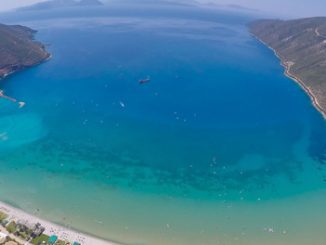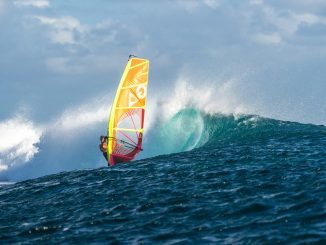
Words: Mic Brignall
Pics: Lawrence Sinclair
Regular WSUK contributor talks about the merits of windsurfng back in UK waters and not just aboard on your holibobs.
Skateboarding, surfing, snowboarding: these sports all have something in common (and it’s not just the letter S!). Supposedly their heyday has been and gone – some say the same as windsurfing. It’s a sad thought, but not necessarily true. When it comes to windsurfing the sport’s more accessible than ever! There might not be a set up in every other household but the amount of centres overseas is truly staggering – Vassiliki, Greece, has five centres alone, and Lake Garda, Italy, also has five! That tells you something. It could even be argued, based on some reports, that more people are trying windsurfing than before, but fewer are bringing it home to UK waters (maybe). The perception is windsurfing is a wholly inconvenient sport, yet it doesn’t need to be. These days there’s plenty more ways to windsurf than simply rigging up a big sail and board.
An introduction to myself though: I have been windsurfing for 14 years now, beginning in Scotland. My parents wanted to find an activity that we could all do together, as I refused to go on walks or ride a bike. So, they decided that we would all take up sailing; being the annoying brat I was, I wanted to windsurf instead. Fast forward a few years, several Neilson holidays later, and practice at the sailing club (I admit, I used to sail as well), I was 14 and happily planing in the footstraps on an 8.5m – something not many kids my age could do. Sadly, life got in the way and I began competitively kayaking. My windsurfing became limited to one or two weeks a year during trips.
The next stage of my windsurfing came in 2013 when I earned my RYA Windsurf Instructor qualification. The year after, when I was 18, I worked at a nearby school teaching sailing, windsurfing and other assorted sports. Soon after I began teaching with Neilson, and have been ever since. Through this experience I have seen the issues of holiday windsurfing, attempted to find ways around it, but most importantly found my love for the sport. Every little move is an achievement, something to be proud of.
Windsurfing can take you around the world, but domestic windsurfing in UK waters is tricky, or at least perceived to be. The water isn’t as balmy as the Med, wind is driven by low pressure systems as opposed to Trade or thermals, and brand new off the shelf kit isn’t cheap!
The very first thing needed to windsurf, before anything, is find somewhere to do it. A perfect location should be local, with breeze. A few extra amenities is always nice but not essential. Many go abroad to get this perfect set up: soft sand, warm water and kit already rigged on the beach! Life doesn’t get much easier. The Aegean Sea has the Meltemi to provide great breeze, Sardinia has the Mistral, Vass has ‘Eric’, The Canary Islands have their own unique winds and so on.
The UK has no lack of good – even great – spots though. A quick Google search usually finds somewhere to windsurf; many places already have windsurf clubs. We all know it’s more fun to windsurf with other people, so why not investigate? It’s a great way to learn too! Sometimes it can take experimentation; my local spot in Edinburgh is a tiny loch, only 5ft deep. It’s perfect for learning new moves, and as it’s surrounded by land. If anything goes wrong then it’s only a short swim in! Lochs and lakes are available to explore, it could become your personal spot (but always be willing to share, not necessarily just with other windsurfers…). Windsurfing doesn’t have to be confined to coastal locations.
The other thing that may be off-putting is the UK’s climate. Sadly, there’s not a lot to be done about the actual temperature of the air and water during off seasons. Wetsuits are great at keeping you warm and technology has greatly improved. It’s now not unusual to be hot in rubber even when air temps are low. Sure, neoprene is not as cool as boardshorts but then needs must. A well fitted wetsuit will keep your body heat in, and you can get extra thick steamers with hoods for those particularly cold winter days. When the right gear is available, there’s no excuse not to be out and before long it’ll be all smiles.
In an ideal world, we’d all have jobs that we can do whenever. I read about a group of guys based near Rutland Water who are all electricians, plumbers and similar. These guys work hard, but when the wind comes they have nothing to stop them jumping in their vans and heading to the lake. If we were all in the same boat the world wouldn’t work and no windsurf boards would ever be made, so that’s not possible… It does take a number of stars to align to allow a full power windsurf session. Some of these are controllable, others are not.
Firstly, it needs to be windy. We can’t make it windy, but we can up our chances. I’m not going to recommend moving house and uprooting the family simply for windsurfing, but beginning in a good location always helps! Secondly, it’s wise to know when it’s going to be windy, and this is the job of weather forecasting sites, such as Windguru. Everybody has multiple commitments, but if it’s going to be blowing thirty knots on Saturday morning, work around it if you can. Plan the weekend accordingly. Should you be blessed with kids, it can be a nice family outing to the beach. Depending on their age, get them out with you on light wind days this way you may be forgiven when it does get windy and disappear. And have a back up plan. Stand up paddle boards these days are session savers if supplied with rig attachments. Light air riding shouldn’t be sniffed at as it can help with developing skills as well as getting you afloat.
Of course, Sod’s Law says that it’ll actually be blowing on Wednesday afternoon. It’s still possible to get an after work session in, depending on your work hours and daylight. Pack the car with your kit before work, and head on over straight after. It’s easy not to commit but the skill is fitting short sessions in often (this I can totally agree with and recommend – ed). Rather than waiting for the perfect day, which can take months, head out whenever you have a spare couple of hours and the forecast is positive. Going out in light winds is a great way to practice high-wind moves, and flowstyle (light wind freestyle) is a skill in its own right. And with things like foiling becoming ever more accessible the lighter wind part of windsurfing is set to be revolutionised.
Now for the delicate part – money. Just like any sport windsurfing isn’t cheap. All hobbies cost though and once the upfront cost is dealt with windsurfing can be reasonably inexpensive. Think of it like a gym membership. Instead of pumping pounds into pushing weights around re-direct it towards windsurfing gear as after all it’s better to be outdoors than stuck inside, surely?!
All sports have hype about why the latest equipment is the best. It’s the same with windsurfing. If you’re just getting into windsurfing, or haven’t had much practice, older kit is no issue at all. You don’t have to hand over a year’s worth of mortgage payments to get afloat. Secondhand gear is perfectly fine to use. Check out eBay and quality retailers like Boardwise in the Midlands who do a great line in used quality kit.
Unfortunately no matter how much equipment you own there’s a chance of getting skunked – at least in terms of scoring planing conditions. As we said before have a plan B. Get hold of an inflatable SUP for windless days. Make sure it has a mast insert for windSUP action. Basically anything to get you wet. Holiday windsurfing is great, and I can’t recommend a windsurfing trip enough, but ultimately to really scratch that itch and also improve you need to be sailing as regularly as possible.
Windsurfing in the UK is changing and no longer should it be thought of as cumbersome or inaccessible outside of overseas resorts and teaching establishments. There are so many products and ways to help fulfil your windsurfing dreams. The key is not getting fixated on any one type of sailing (waves, slalom) and instead embrace the opportunity of being on the water. You’ll be glad you did!
Alternative windsurfing kit to get you afloat whatever Mother Nature’s mood –
Arrows Inflatables iRig (S, M, L) – inflatable windsurf rig that (REALLY) works in super low winds. Plug into your SUP (inflatable or rigid) or conventional big freeride board and enjoy some light wind fun. Also great for initial forays into windsurfing.
Inflatable SUPs – many inflatable SUPs (especially those from the bigger windsurf/stand up paddle brands) offer blow ups with rig attachments. Get involved and get cruising when it’s too breezy to paddle.
Inflatable windsurf boards (planing) and compact rigs – we’re seeing more of these products appear from major brands. Having a fully functioning planing windsurf board, but in inflatable form, with foldable compact rig could be one way to own bigger cumbersome kit.
Foils – yes, we appreciate foiling gear is another pricey bit of kit. But opening up the sub-15 knot wind barrier and allowing sailors to do away with big rigs could deliver foiling as an actual cost saving piece of equipment in the long run. It’s also a completely different sensation which may become addictive!
Longboards – longboard windsurf boards are still one of the most efficient pieces of gear for light airs. They’re also available second hand for pretty cheap. Using this equipment for cruising is one thing but how about journeying from destination A to B? This is where the real magic of longboards lies.









Leave a Reply